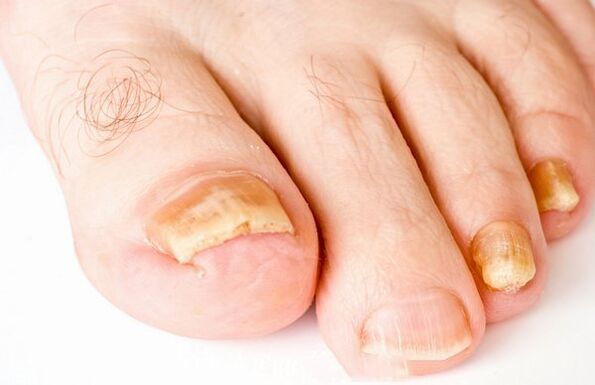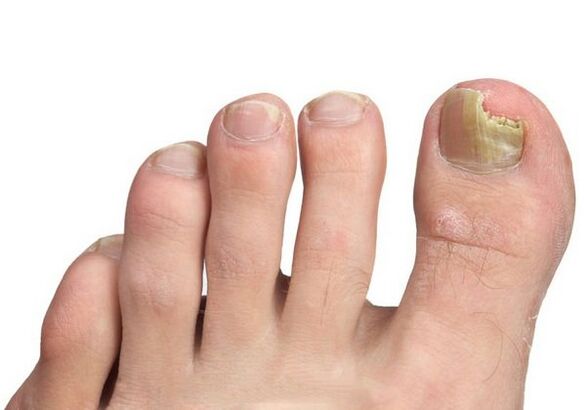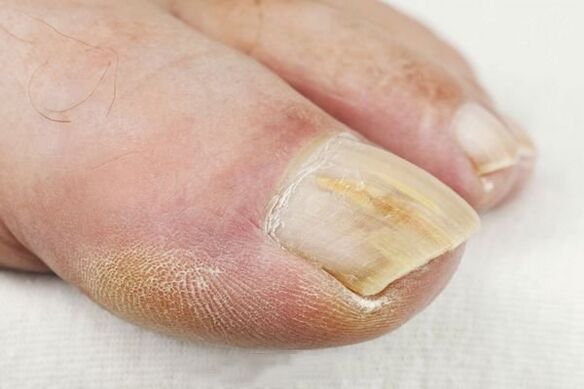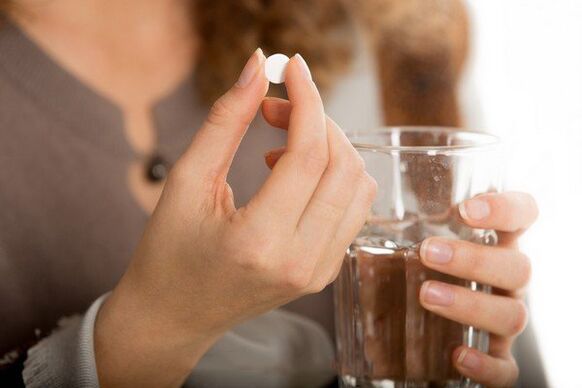Hello, dear readers.Onychomycosis is a medical name for a very common disease, best known to us as nail fungus.Recently, a jump at the incidence level of this disease has been observed.This unpleasant fact is associated with the popularity of free shoes, which is not particularly quality.Madhe made of low -grade materials that have low air turnover, which prevents normal foot ventilation.In such conditions, with foot sweating, ideal conditions for the manufacturing activity of the pathogenic microflora are created.This problem is widespread.Its extension is so large that the number of cases exceeds 20% of all the inhabitants of the planet!
As the name implies, nail fungus are a mycotic damage to the nail plate.There are many types of pathogenic fungi that can cause this disease.
But, according to doctors, in most cases, the nail plates are affected by dermatophytes.Significantly the cause of the development of the disease is the yeast (candidate) and mold fungi.
Sometimes in practice you have to deal with nail deformity at the feet of a black nature.
Symptoms of nail fungus - first signs
Damage to the fungus can affect not only the nails but also the feet themselves.The symptoms in the infection will vary depending on the variety of the pathogen that caused the development of the disease.The rate of damage to the nail plate also has a value.
But despite existing changes, the general signs of fungal activity can be distinguished:
- Change of nail color.
- The appearance of stains on the nail plate, stripes, obesity, flux.
- Release of nail structure or their stratification.
- Redness, peel, skin cracking.
- The appearance of itching, pain (including when walking), burning in the damage area.
- Inflammation, dryness of the affected areas of the skin.
- Often the legs extract a repulsive aroma.
A white plate can be observed at the bottom of the legs.Skin peeling is replaced by the appearance of small dead skin accents, which cover its surface.
Types of fungal lesions
Normotrophic form of damage.Points or white or yellow strips appear on the nails.As the disease progresses, they spread, gradually completely changing the color of the entire plate.
The thickness, as well as the brightness of its surface remains unchanged.There may be a nail melting violation with submarine fabrics, which is why it extracts and can be removed easily and painlessly.

The hypertrophic form of the disease.The affected nail becomes brown or gray.A thickening of the nail plate is observed due to the increase in the submarine epithelium.The nail plate itself becomes a crumb.
The sides are particularly destroyed, because of this it adopts a claw -like shape.This is a characteristic sign of this disease.The nail surface becomes dull.When you walk, a sick person experiences pain.
Atrophic form of damage. The nail plate changes color, becoming brown-gray, loses its transparency and shine.The nail begins to collapse gradually, starting from the outside towards the nail growth area.
The growing epithelial particles fill the nail bed with loose mass.Without treatment, a complete loss of nails will occur.
Classification according to the pathogen of the disease
Dermatophytic lesion.Occurs in the vast majority of cases (about 90%).There are several types.With some, the infection can be applied to inter -legged areas, to the skin of the feet and even the hands.
May loss.This variety can be difficult to identify, especially in the initial phase.The nail roller is first affected, it inflammates and swells.Later, the peel in this area is obvious, mild itching and poor pain can be possible.The nail becomes tuberous, it loses its brightness, it can crumble.In advanced cases, purulent discharge appears.
Planeal loss.Under the influence of mold, the nail changes, taking a green coloring, bluish or starts to extract.
Its lateral parts become rough.Over time, the affected areas die, which is why the nail is deformed.Gradually, it will collapse.
The loss of the plan is quite rare, mainly as a complication of a different form of fungal lesions as well as with HIV infection.
Classification according to the location of the lesion
Mushroom damage can be located in different parts of the nail.In this regard, some types of damage are distinguished in the international classification.
- In total when the mushroom effect covers the entire nail.
- Distant, if only the upper part of the nail (free edge) is injured.
- Proximal, in which there is a nail roll damage (the bottom of the nail plate).
- Side, observed in the lateral parts of the nails.
Often they characterize different stages of the disease.
Fungal lesion
There are several types of damage to the fungus in the legs.
Interdalz form. The most common type of foot fungus.While the name can be seen, the disease affects the interdigital gaps, later it can also pass through other parts of the legs, including nails.
In interdigital folds, moist cracks and specific layers of the skin first appear.Later, skin erosion is noticeable.The disease has a tendency to develop in the chronic.Often complicated by streptococcal infection
Hypercan (squamous) form.Touch the whole leg.It changes to a fairly deep loss of tissue.At first, the skin peel and blush slightly, then it becomes harsh and thirsty, sometimes there is a deep crack of the keratinized layer.
The disease can spread to the nails, which at the same time thicken, darken and begin to paint.The disease is very characteristic of athletes.
Double (vesicular) form. Vesicula (juicy bubbles) appear on the feet, which, after being broken, leave traces of erosion.The skin becomes ulcerated, with peel areas, covered with purulent crust.It is often associated with an allergic rash (due to the action of toxins).
The disease is rare and treated quite easily.But here the risk lies in the high probability of lesions of bacteria or viruses, which significantly complicate the course of the disease and actually excludes the possibility of rapid healing.
Deleted form.It is not easy to identify, as the skin changes and the condition of the nails are weak.The nail plates can become yellow.The skin in the single is a little peel, it becomes loose.Itching can be observed.The disease is well borrowed to cure.
Nail mushrooms - Causes of appearance
Symptoms of nail fungus and the first signs that signal the overall level of body immune resistance and improper care for the feet.

If protective functions are normal, then even when infected, the disease will not be able to develop.Immune mechanisms will withstand the aggressor himself.
But when immunity weakens with regard to the causes associated with favorable development of the disease, the body will not be able to resist the fungus.
For an effective fight with it, you should try to eliminate or at least minimize (for example, chronic diseases are unlikely to be completely overcome) the impact of these factors.
Reasons for the development of fungi:
- Excessive foot sweating.
- Violation of natural foot ventilation (dense shoes made of low quality materials, synthetic socks).
- Reducing body protection functions.
- Violation of the protective layer of the skin (excess hygiene, excessive treatment with antibacterial agents, fluid abuse to relieve varnish).
- Damage to the nail plate and single leg damage (cracks, corn, etc.).
- Features of the leg that exacerbates its ventilation (due to flat feet, overweight, etc.).
- Associated diseases (diabetes, varicose veins, psoriasis, metabolic disorders, digestion, blood circulation, HIV).
- Antibiotics and some other medicines taken from a long course.
- Low level of foot hygiene.
- Age and sexual criteria (men and the elderly are more susceptible to disease).
- A professional factor (high temperature and humidity conditions, dust, ionizing radiation, wearing rubber shoes; massages, orthopedists, sanatorium workers, steamers, etc.) also often get sick.
- A visit to public sauna, baths, pools.
- The salon pedicure contrary to the principles of hygiene and infertility.
- Homemade factor (general use of washing clothes, slippers, baths in the bathroom, etc.).
As studies have shown, people suffering from diabetes are more affected by the fungus of the leg and nails.This disease is observed in 35% of diabetics.
The probability of damaging fungi in psoriasis is also high.Here the probability of growing by 55%.
The consequences of fungal lesions

Although the fungus of the foot does not pose a direct threat to the patient's life, you cannot connect with your health irresponsibly and let everything go on your own.
Mushroom damage is not at all an annoying trouble and an extremely aesthetic problem.
The timely mismatch of the disease leads to the development of a chronic form of the disease with regular irritation.
Surprising complications are also possible.
- Violation of the nail growth process, growing in soft tissue.
- Full or partial loss of nail.
- Stagnant phenomena, including lymphostasis.
- Distribution of the disease in neighboring areas and deep in tissues.
- Link of other infections (bacterial, viral and fungal).
- Elevated inflammation is an acute infectious inflammatory disease.
- Diabetic foot in diabetics is anatomical changes, leading to an increase in the likelihood of damage, infection, soup and necrosis of the tissue.
- Elephantiasis is a pathological growth of the skin and subcutaneous tissue, leading to an increase in organ size.
- Eczema
Treatment of nail fungus - cheap and effective medicine
To describe the right treatment regimen, you need to make an accurate diagnosis.For this purpose, a number of laboratory tests are performed.Modern pharmacology offers a great high antifungal drug.
That is why independent treatment is difficult and often turns out to be ineffective.The doctor will need to detect the pathogen, the degree of neglect of the disease, the area of damage, the presence of simultaneous diseases.
Only based on the information complex received, it will be able to describe a course of therapy.Here, both local medicines are used (for external application - ointments, lotions, spray, foam, serum), and general, obtained inside (tablets, capsules).
Active substances in antifungal ointments can be cyclopiroks, naftyphin, nistatin.
If fungal lesions are quite wide, the use of antimycotic tablets of tablets is recommended.
Unlike external funds, tablets have an overall effect on the whole body of the patient.
Purely prescribed medicines based on the substances of terbinafine, fluconazole, itraconazole.There is often a need for surgical removal of formations, but there are free and effective medicines from nail fungus.

Many of these funds are also shown for preventive use.
It should be remembered that all antimicotic drugs have a different side effect.Therefore, treatment, prescription and cancellation of medication, patient condition control - all this is exclusively within the competence of the physician.
Often, the recovery process can be very prolonged, up to one year, until the affected nail is completely updated.
During the treatment period, special attention should be paid to the toe hygiene.With damage to fungal nails, the use of decorative spray is not allowed.
To prevent families from infection, you cannot walk barefoot at home, wearing closed shoes is allowed only.It should be treated twice daily with antifungal agents.After using the bathroom, its careful processing is performed.
The joint washing of things is forbidden.After the cure, you need to get rid of all the objects that have contacted their feet (washing clothes, slippers, all socks, etc.).
RECOMMENDATION
- The legs should be kept clean and dry.Wash your feet once a day, if necessary - more often.After that, their surface, including interdigital gaps, diligently dried.Now you only need to wear fresh socks.
- Shoes should be comfortable, not too old (no more than 3 years), from a breath material.Fashionable or fashionable rubber patterns cannot be worn daily.At least, the duration of her dress during the day should be limited.For this purpose, it is recommended to use a replaceable pair.It is extremely recommended to use other people's shoes, including slippers.
- Ocksatrapes are used from cotton, wool or other non -intensity materials.It is permissible to wear synthetics only in a few cases.
- The hardest thing is to destroy the mushrooms on the wooden surfaces.This should be considered when visiting public steamers, baths, pools.It is better to be in a closed rubber shoe.
- Ocksatrapes, shoes in the room, bedding should be adjusted regularly.
- The procedure for salon pedicure should be performed by a proven master subject to the rules of sterility.Or at home adhering to the same principles.It is necessary to avoid all kinds of nail plate damage in any possible way, to timely eliminate the characteristic problems of the single surface (soft forms, corn, cracks), do not abuse the pedicure, degeneration and disinfectants.
Take care of yourself, follow your health.Be healthy!
















